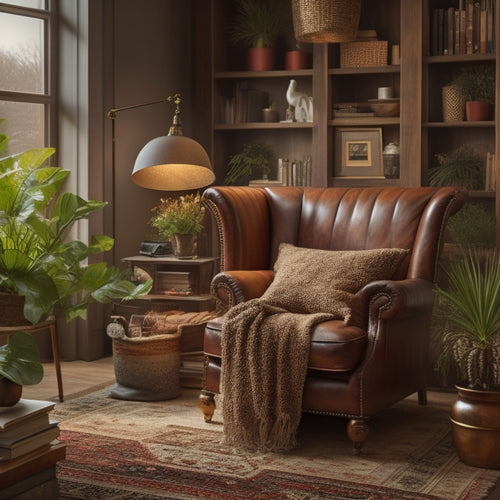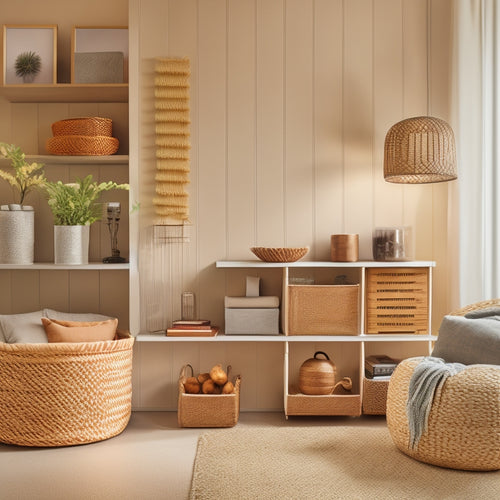
5 Proven Strategies for ADHD-Friendly Home Organization
Share
You'll thrive in an organized home that accommodates your ADHD. Start by creating a home for everything, labeling, and decluttering. Visual reminders like color-coded labels and sticky notes help you stay on top of tasks. Break down large tasks into smaller, manageable chunks, and prioritize them. Designate a clutter-free "launching pad" for essentials, and make organizing a daily habit. By implementing these 5 strategies, you'll create a space that supports your productivity and reduces stress. As you apply these principles, you'll uncover even more ways to tailor your space to your unique needs and transform your daily life.
Key Takeaways
• Establish a home for everything using designated spots, labels, and storage solutions to reduce clutter and increase productivity.
• Utilize visual reminders like color-coded labels, sticky notes, and dividers to enhance focus and stay on track.
• Break down large tasks into smaller, manageable chunks, prioritizing importance and urgency, and allocating realistic time estimates.
• Designate a clutter-free "launching pad" for essential items, ensuring visibility and accessibility to streamline daily routines.
• Develop a consistent morning routine that incorporates organizing habits, such as time blocking and decluttering, to reduce stress and increase structure.
Create a Home for Everything
Assign a designated spot for each item in your home, making it easier to find what you need when you need it. This is the foundation of creating a home for everything. By doing so, you'll reduce stress and save time searching for misplaced items.
Implement a labeling system to identify where things go, and use decluttering methods to get rid of items you no longer need or use. This will help you focus on what's essential and make the most of your space.
Invest in storage solutions like bins, baskets, and shelves to keep items organized and out of sight. Utilize organizing tools like hooks, baskets, and dividers to maximize your space.
For example, use a hook near the entrance for your keys, and a basket for your mail. By creating a home for everything, you'll establish a sense of routine and structure, making it easier to maintain your space.
Use Visual Reminders Effectively
By creating a home for everything, you've set the stage for implementing visual reminders that will help you stay on track and remember important tasks and deadlines. Now, it's time to make the most of these reminders.
Use color-coded labels to categorize tasks, such as red for urgent, yellow for important, and green for routine. This visual system will help you quickly identify priorities and stay focused.
Sticky notes are another effective tool for visual reminders. Place them in strategic locations, like on your fridge, desk, or bathroom mirror, to make sure you see them frequently. Write down reminders, such as appointments, birthdays, or tasks, and use different colors or symbols to differentiate between types of reminders.
You can also use sticky notes to break down larger tasks into smaller, manageable chunks.
Break Down Large Tasks
When faced with a challenging task, try dissecting it into smaller, actionable steps that you can tackle one by one. This task management strategy helps you focus on the process, rather than feeling overwhelmed by the end result.
Break down the task into smaller, manageable chunks, and prioritize them based on importance and urgency.
Next, assign a specific time block for each step. This technique, known as time blocking, allows you to dedicate a set amount of time to each task, ensuring you stay on track and make progress.
Be realistic about how long each step will take, and leave some buffer time for unexpected distractions.
Designate a Launching Pad
Create a designated launching pad, like a hook or tray near the entrance of your home, where you can place essential items like your keys, wallet, and bag, so you can easily grab them on the go. This organizing essential will save you time and reduce stress when you're rushing out the door. By designating a specific spot for these items, you'll avoid last-minute scrambles to find what you need.
Decluttering tips come into play here, as a cluttered launching pad can quickly become overwhelming. Keep only what you need in this spot, and consider using a small tray or bin to corral smaller items like change or receipts. Make sure the launching pad is easily accessible and visible, so you can't miss it. This simple habit will become a game-changer for your daily routine.
Make It a Habit Routine
Now that you've designated a launching pad, make putting essential items in their place a daily habit by incorporating it into your morning routine. This simple step can greatly impact your daily organization.
By doing so, you're establishing structure and developing consistency in your daily routine. Start by setting a specific time each morning to put away items that are out of place. It can be as short as 10-15 minutes. Make it a non-negotiable part of your daily routine, like brushing your teeth or taking a shower.
As you make it a habit, you'll find that it becomes second nature to put things back in their designated spot. This habit will help you maintain your space and reduce stress.
Remember, the key is to be consistent. Stick to your routine even on weekends or days off.
Frequently Asked Questions
How Do I Maintain My Organization System When I'm Feeling Overwhelmed?
When you're feeling overwhelmed, take mindful breaks to recharge, prioritize tasks to tackle one at a time, and set boundaries to protect your time - don't forget to prioritize self-care practices to maintain your organization system.
What if I Have Limited Space for My Organized Areas?
Like a puzzle piece, you're fitting into a small space, requiring creative storage solutions to maximize space. Invest in multi-functional furniture and dual-purpose items, such as storage ottomans or desks with built-in shelves, to optimize your area.
Can I Use Digital Tools for Visual Reminders Instead of Physical Ones?
You can definitely opt for digital tools over physical reminders, leveraging virtual organization apps to keep yourself on track, and freeing up physical space in the process, which suits your limited space constraints.
How Do I Get My Family Members to Follow the New Organization System?
To get your family on board, you'll need to communicate the benefits of the new system clearly and set boundaries. Establish consistent enforcement, making certain everyone understands their roles, and be open to feedback to guarantee cooperation.
What if I'm Not a Morning Person and Can't Stick to a Morning Routine?
You're not a morning person? No problem! Swap morning routines for nighttime productivity, leveraging your most focused hours. Flexible scheduling helps you create a personalized rhythm, ditching rigid timetables for a system that truly works for you.
Related Posts
-

Budget-Friendly Ideas for a Cozy Home Library
You can transform any space into a cozy home library without breaking the bank. Start by decluttering your book colle...
-

Effortless Home Organization Systems for Busy Families
You can create an effortless home organization system that caters to your busy family's unique needs and routines. St...
-

10 Best Space-Saving Hacks for Tiny Guest Rooms
You're about to transform your tiny guest room into a cozy retreat that's both functional and aesthetically pleasing....


